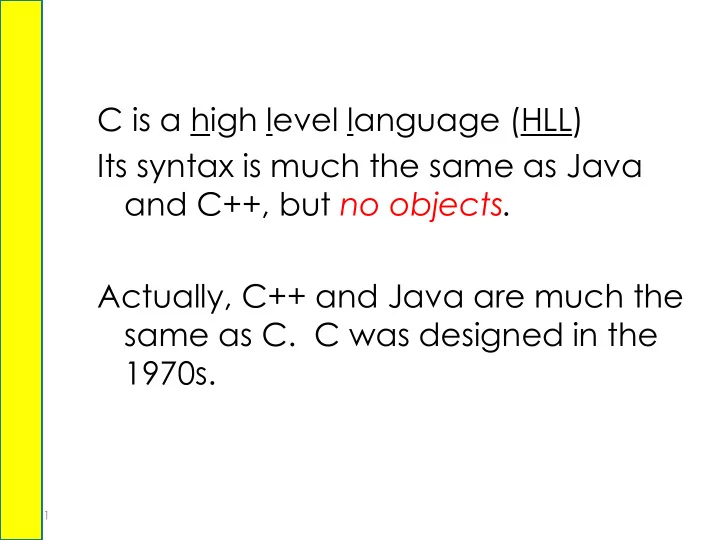

C is a high level language (HLL) Its syntax is much the same as Java and C++, but no objects. Actually, C++ and Java are much the same as C. C was designed in the 1970s. 1
Java 2
C 3
Why C ? 1. Millions of lines of code have been written, so you are going to run into it. One place you are likely to run into it are the UW-Madison 500-level CS systems classes. 2. It gives a common language to reference, so the remainder of 354 can base examples on C code (not Java, C++, Ruby, Python, etc.). 3. Any C++ programmer also needs to know C. 4
Comments in C code /* my comment */ opening delimiter closing delimiter comments may span lines 5
/* hello world program */ #include <stdio.h> main() { printf( " hello , world\n " ); } 6
C’s printf() is like: Java’s System.out.print() or C++’s cout 7
Java source code compiler Java “byte codes” Java interpreter (JVM) 8
high level language source code compiler assembly language source code assembler machine code linking and loading execution 9
high level language source code C preprocessor C compiler assembly language source code 10
the C preprocessor does 1. #include 2. macro substitution for example: #define MAX 100 3. conditional compilation 11
#include <stdio.h> #include " myheaders.h " 1. 12
#include <stdio.h> 2. #define MAX 100 main() { int x; x = 1; while (x <= MAX) { printf( " %d\n ", x); x++; } } 13
C's basic types • char – An ASCII character. Typically 1 byte. • int – A 2's complement integer. Typically the size of a word on the architecture. • float – An IEEE single precision floating point value. 32 bits. • double – An IEEE double precision floating point value. 64 bits Not listed here: pointer types. 14
Type qualifiers If and when you believe you need to use these, look them up: • signed • unsigned – causes integer arithmetic operations to be ones for unsigned integers • long – relates to size • short – relates to size • const – do not use this qualifier to define a constant. What happens when code tries to change a variable declared as const is implementation dependent. 15
C string An array of characters, which uses the null character to delimit the end of the string. '\0' is the null character. All zeros bit pattern in ASCII. "Hi." "12" 16
I/O Concept and Implementation Logical places where input comes from and output goes to: stdin stdout stderr 17
Output (in the stdio library) int printf (char *format [, arg1] … ); function string, called optional, name the as referenced format string by string return value: # characters printed 18
printf( " howdy " ) ; howdy A better way to do this (for security reasons) is puts("howdy"); 19
Within the format string , to reference variable (values): %d for an integer %u for unsigned %c for a character %s for a string Each % character references an argument 20
int x, y; x = 3; y = 5; %d %d printf( " = %d\n " , x, y, + x + y); newline character 3 + 5= 8 ^ 21
#include <stdio.h> main() { int x; OUTPUT x = 354; printf("[%d]\n", x); [354] printf("[%1d]\n", x); [354] printf("[%2d]\n", x); [354] printf("[%3d]\n", x); [354] printf("[%4d]\n", x); [ 354] printf("[%-4d]\n", x); [354 ] } Optional field width 22
#include <stdio.h> main() { float x; OUTPUT x = 1234.5678; printf("[%f]\n", x); [1234.567749] printf("[%1f]\n", x); [1234.567749] printf("[%2f]\n", x); [1234.567749] printf("[%20f]\n", x); [ 1234.567749] printf("[%-20f]\n", x); [1234.567749 ] printf("[%1.2f]\n", x); [1234.57] printf("[%-2.3f]\n", x); [1234.568] printf("[%-20.3f]\n", x); [1234.568 ] } 23
Recommend
More recommend